Ken-Betwa Link: Not Enough Land to Compensate for 23 Lakh Trees Cut, Govt Tries to Bend Rules
This is the second in a six-part series on the Ken-Betwa Link Project. Read the first article here.
Chhattarpur/Panna: Gauri Shankar Yadav was alarmed when he heard that a dam was to be built in his village, Daudhan, which is situated about 700 metres from the Ken river within the Panna Tiger Reserve area.
The inhabitants of Daudhan, mostly members of tribal communities, depend upon the river and the forest for their livelihoods.
The dam, which is part of the first phase of the construction of the Ken-Betwa Link Project (KBLP), will see Yadav and his fellow villagers evicted from the area. About 23 lakh trees will also be cut down.
“Our lives depend on these forests,” said Yadav. “We collect mahua, sell wood, chop bamboo. Those who are now forced to migrate to big cities like Delhi could earlier earn enough here to survive. The destruction of these forests would cause irreparable damage not only to us, but to the area.”
For people like Yadav who not only depend on the forest but have a strong connection with it, the KBLP is disastrous.
But unable to find alternative non-forest land to compensate for clearing such a vast forested area for the project, the Modi government now wants the ministry of environment, forests and climate change (MoEFCC) to relax the conditions it had laid down when it granted the Stage-I clearance or in-principle approval to the disputed KBLP on May 25, 2017.
Ministers and senior officials of the Ministry of Jal Shakti are pressurising the MoEFCC to relax the conditions, arguing that the Ken-Betwa Linking Project is of ‘national significance’.
Also read: Ignoring Damning SC Panel Report, Modi Govt Kickstarts Work on Ken-Betwa Link Project
The Modi government also faces another problem. Not all of the land that the Madhya Pradesh government has marked out as compensation to the forest department for diverting the forest area under the KBLP belongs to the government. Some of it belongs to local residents, according to documents accessed by The Wire under the Right to Information (RTI) Act, 2005.
Not enough land
On May 25, 2017, the Forest Conservation Division of the MoEFCC approved the diversion of 6,017 hectares of forest land, which is equivalent to 8,427 football fields, for the non-forestry purpose of the KBLP on the recommendation of the Forest Advisory Committee (FAC).
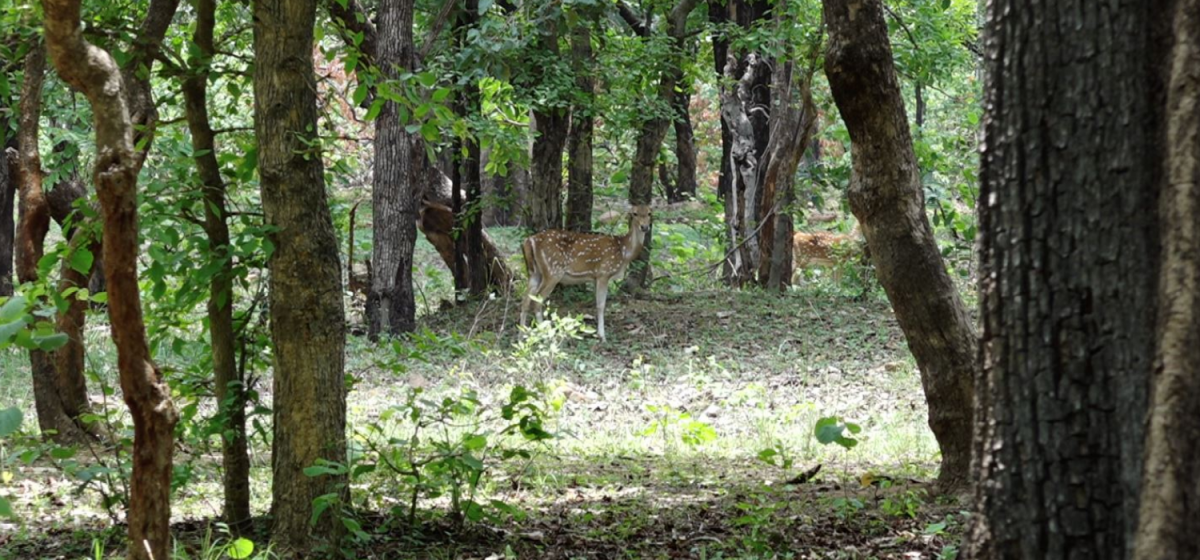
Panna Tiger Reserve area. Photo: Dheeraj Mishra
In other words, the environment ministry granted permission to cut down at least 23 lakh trees in the region, including trees in 4,141 hectares of forest area in the core of the highly sensitive Panna Tiger Reserve.
However, this permission was granted on the condition that the government would provide an equivalent amount of non-forest land to the forest department for afforestation. Having failed to find 6,017 hectares of non-forest revenue land in the last three years, the government is now pressuring the MoEFCC to drop this condition.
In a letter dated July 30, 2018, to C.K. Mishra, the then secretary of the MoEFCC, U.P. Singh, the then secretary of the Ministry of Water Resources, River Development & Ganga Rejuvenation (later renamed the Ministry of Jal Shakti), stated that “the Madhya Pradesh government has expressed difficulties in providing 6,017 hectares of revenue land (non-forest) and resettlement and rehabilitation of the families residing in the revenue land to be identified.”
The MP government could locate only 4,206 hectares of non-forest land of the 6,017 hectares required for compensation to the MoEFCC and were it to seek more land to fulfil the entire compensation package, it would also need to resettle and rehabilitate the people residing on that land. Therefore, the letter said, the condition imposed by the MoEFCC should be relaxed.
Singh also wrote that the chief minister of Madhya Pradesh, via a letter dated October 11, 2017, had requested the Union water minister to take up the issue of relaxing the condition of the transfer of 6,017 hectares of revenue land to the Panna Tiger Reserve (PTR) authorities.
Ken-Betwa Link Project by The Wire
In the letter, Singh proposed that in exchange for the 1,811 hectares of non-forest land that could not be provided, the MP government could give double the amount of degraded forest land, that is, 3,622 hectares, in the Chhattarpur district, for compensatory afforestation.
Environmental experts say that Singh’s proposal is a gross violation of environmental rules and dangerous from the ecological perspective.
In response to Singh’s letter, C.K. Mishra asserted in a letter dated December 19, 2018, that “the identification and transfer of non-forest land equal to the total amount of diverted forest land is an essential condition of the Stage-I forest clearance, which was approved by the government”.
However, Mishra added in his letter that he had passed on Singh’s appeal for the relaxation of the conditions to the MoEFCC officers concerned, asking them to examine the request and take it up with the appropriate authority if it could be considered.
“In the meanwhile, I would also request that the state government should make efforts to comply with all other conditions stipulated in the Stage-I approval,” Mishra’s letter continued.
Later, the Ministry of Jal Shakti addressed letters to the additional director general (forest conservation) on July 17, 2019 and February 5, 2020, to expedite the matter of relaxing the conditions, but no response was received.
During the 17th meeting of the Special Committee on Interlinking of Rivers held on February 26, 2020, at Vigyan Bhawan, New Delhi, the additional chief secretary of the Madhya Pradesh government’s water resource department reiterated that Madhya Pradesh could identify only 4,206 hectares of revenue land for transfer to the PTR authorities.
In response to this, the then Union water secretary U.P. Singh said: “It is a normal practice to consider compensatory afforestation in double of the degraded forest land and [this] should be accepted by the MoEFCC.”
Also read: Ken-Betwa River Linking Project May be Economically Unviable, Says SC Committee
Later, on June 22, 2020, Bhopal Singh, the director general of the National Water Development Agency (NWDA), the agency of the Ministry of Jal Shakti in charge of implementing the Ken-Betwa Link Project, wrote a letter to Sanjay Kumar, the director general of forests and special secretary in the service, seeking the relaxation of the MoEFCC’s conditions for the project. But there was no response from Kumar.
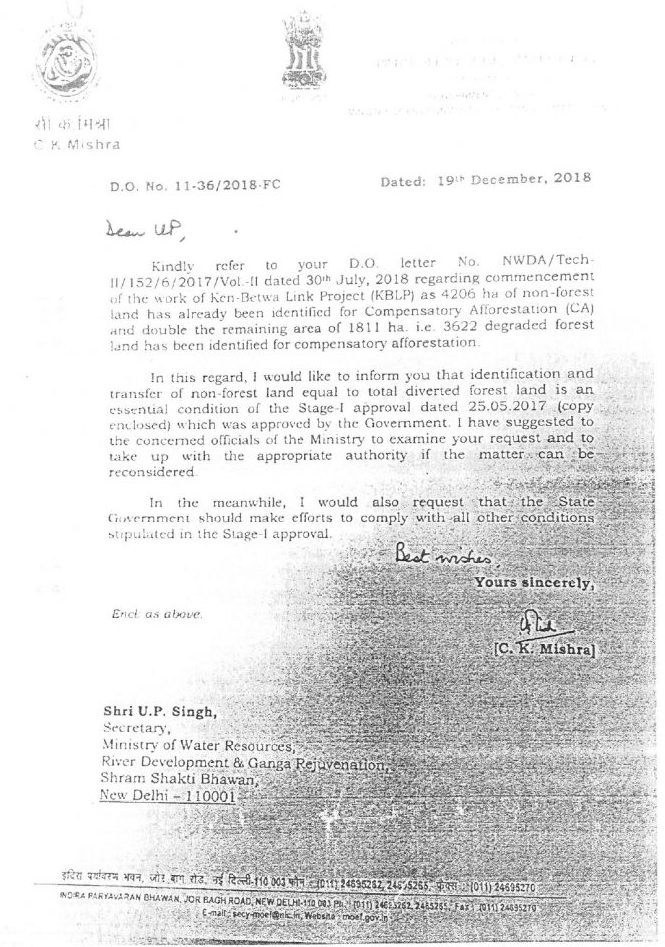
C.K. Mishra asserted in a letter dated December 19, 2018, that “the identification and transfer of non-forest land equal to the total amount of diverted forest land is an essential condition of the Stage-I forest clearance, which was approved by the government”.
The government’s discomfort over the conditions imposed by the environment ministry can be gauged from the fact that the issue has been raised in nearly all the KBLP-related meetings over the last two years.
In a July 25, 2019, meeting of representatives from the Madhya Pradesh and Uttar Pradesh governments on the KBLP, U.P. Singh once again insisted that the environment ministry should be asked to take action on the matter of relaxing its conditions.
On September 3, 2020, in another meeting that he chaired, U.P. Singh said that the environment ministry had been asked to consider the Ken-Betwa Link Project on par with a central sector scheme as the project is being implemented as national project and all the requisite clearances had been sought by the Central government.
He added that the Gajendra Singh Shekhawat, the Union water minister, had held a meeting with the then environment minister, Prakash Javadekar, regarding the matter.
‘Conditions cannot be modified’
Bhopal Singh told The Wire that the Jal Shakti ministry faces a lot of challenges due to rehabilitation and resettlement works on such a large scale, as a result of which the demand for relaxing the compensation has been tabled before the MoEFCC.
“It is proposed to compensate the MoEFCC by providing about 4,206 hectares of revenue land (equal to the submergence of about 4,206 hectares of the core area of the PTR) in villages adjacent to the PTR and about 3,622 hectares of degraded forest land adjacent to the PTR. The water lake created under the project will also form part of the PTR, thus increasing the overall area of the PTR and its carrying capacity,” he said.
However, Himanshu Thakkar, coordinator of the South Asia Network on Dams, River and People and a member of an expert committee on the project, said non-compliance with the conditions of forest clearance is a gross violation of rules.
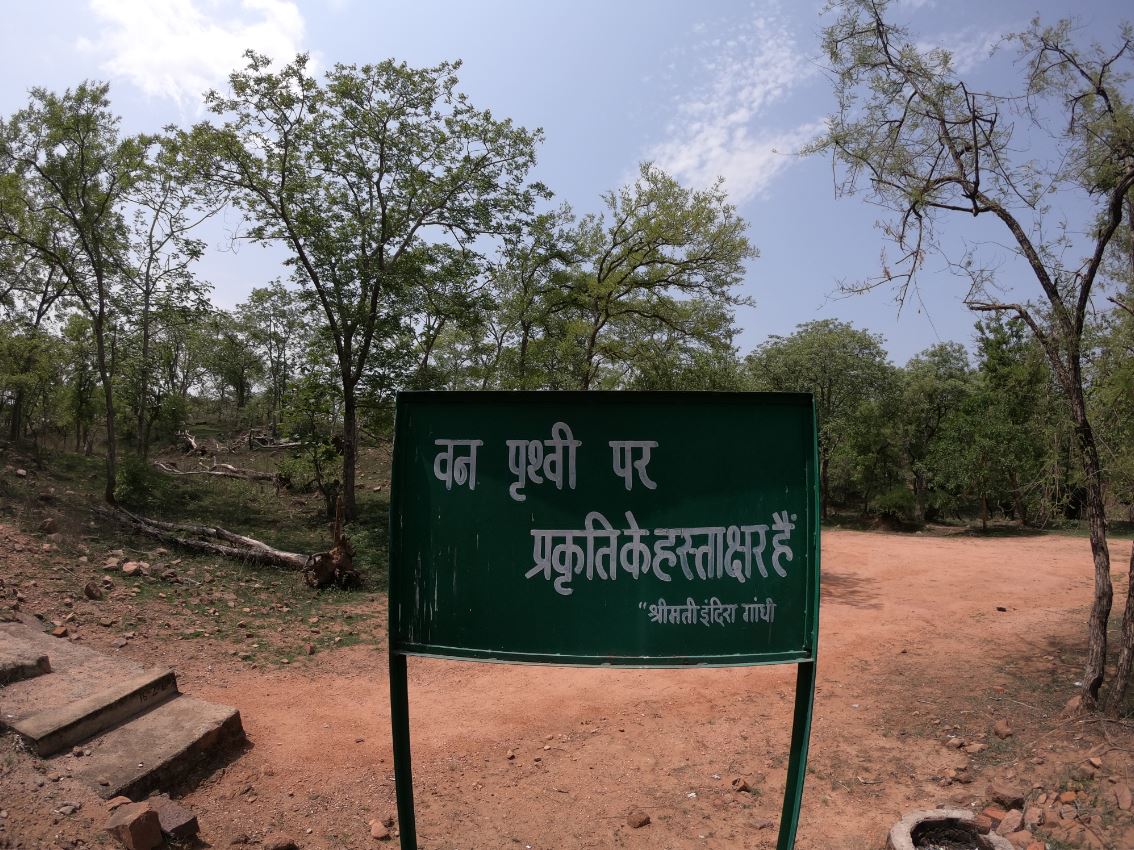
Board outside reserve area. Photo: Dheeraj Mishra.
He said that the conditions were imposed by FAC after detailed deliberation and cannot be modified.
“First, the project has been granted forest clearance on certain grounds. Until these conditions, which apply to Stage-I of the project, are met, further approval cannot be obtained. The FAC had formed a sub-committee of its own, which surveyed the ground situation and laid down the conditions. They should not be altered or modified under any circumstances,” Thakkar said.
Thakkar has been a river activist for the past two decades. He claims that the conditions were imposed in order to mitigate to some extent the damage looming over the Panna Tiger Reserve in the wake of the project. But the government’s attempts to have the conditions eased are likely to aggravate the situation.
He said, “The condition was to add non-forest land contiguous to the PTR so that the area of the PTR can go up. The claim of double the degraded forest land being reforested has no credibility and in any case, that does not help the PTR.”
The Wire has sent an email to the secretary of the MoEFCC and the director general of forests, seeking a response on how they plan to address the demands of the Ministry of Jal Shakti. The story will be updated when a response is received.
Who owns the land meant as compensation?
Documents accessed by The Wire also reveal that out of the total area of 4,206 hectares declared as non-forest by the MP government and offered to the forest department for compensatory afforestation, 823 hectares belong to local villagers.
Also read: Ignoring Damning SC Panel Report, Modi Govt Kickstarts Work on Ken-Betwa Link Project
The environment ministry has not been informed about this fact as yet.
Based on a letter sent by N.C. Jain, the then chief engineer (north) of the NWDA, on July 11, 2018, U.P. Singh wrote a letter to the environment ministry in which he said that 2,179.09 hectares of seven villages to the east of the PTR or the Ken River have been identified as non-forest land. Similarly, to the west of the PTR, there are three villages with 1,009 hectares of non-forest land.
Ken-Betwa Link Project by The Wire
In addition, Singh wrote, there are two villages in the partial submergence area of the proposed Daudhan dam that can provide 1,018 hectares of non-forest land. In this manner, a total of 4,206 hectares of non-forest land could be made available for compensatory afforestation under the Ken-Betwa Link project.
However, the Madhya Pradesh Gazette and documents of the revenue department reveal that only 3,383 hectares of this land is non-forest area while the remaining portion is the property of villages situated in the buffer zone of the Panna Tiger Reserve.
Also read: Environment Ministry Defers Clearance To Ken-Betwa Interlinking Project Dam
Of the 2,179.09 hectares of non-forest land identified in the seven villages on the river’s eastern bank, 761.47 hectares belong to the villagers. In the three villages on the western bank, 60.8 hectares of land belong to the villagers.
These villages in Panna and Chhatarpur districts are Kathari Bilhata, Kauni, Manjholi, Gahadara, Marha, Khamri, Kudan, Pathapura, Naingunwa and Dugaria.

Of the 2,179.09 hectares of non-forest land identified in the seven villages on the river’s eastern bank, 761.47 hectares belong to the villagers.
The NWDA identified Kadwara village in Chhatarpur’s Bijawar Tehsil with 1,011 hectares of non-forest land as the remaining non-forest land to be provided to the forest department in compensation for the 6,017 hectares of forest land that would be used for the KBLP. However, the Madhya Pradesh government has not so far approved of handing over this land to the forest department and nor has the Centre so far informed the environment ministry that not all the land marked for compensation belongs to the government.
One more condition, one more problem
The Jal Shakti ministry has also sought the relaxation of another condition laid down by the environment ministry that work on the KBLP should commence only after Uttar Pradesh’s Ranipur Wildlife Sanctuary and Madhya Pradesh’s Nauradehi and Rani Durgavati Wildlife Sanctuaries have been connected to the Panna Tiger Reserve.
In a letter to the MoEFCC dated July 30, 2018, the Jal Shakti ministry sought approval to begin the river linking project as soon as possible because “connecting the sanctuaries under Project Tiger may take time”.
On September 9, 2020, in a meeting chaired by the then Jal Shakti secretary U.P. Singh, officials of the wildlife department of the MP government said that action had already been initiated regarding the Nauradehi and Rani Durgawati wildlife sanctuaries.
However, the NWDA argued that this condition applied by the MoEFCC may delay the project and Singh responded: “The environment ministry may relax the condition of prior notification of these three wildlife sanctuaries as core/critical tiger habitat before the commencement of project work and allow simultaneous implementation of KBLP and integration of sanctuaries to avoid delays and cost over run in the project.”
The MoEFCC is yet to approve this demand.
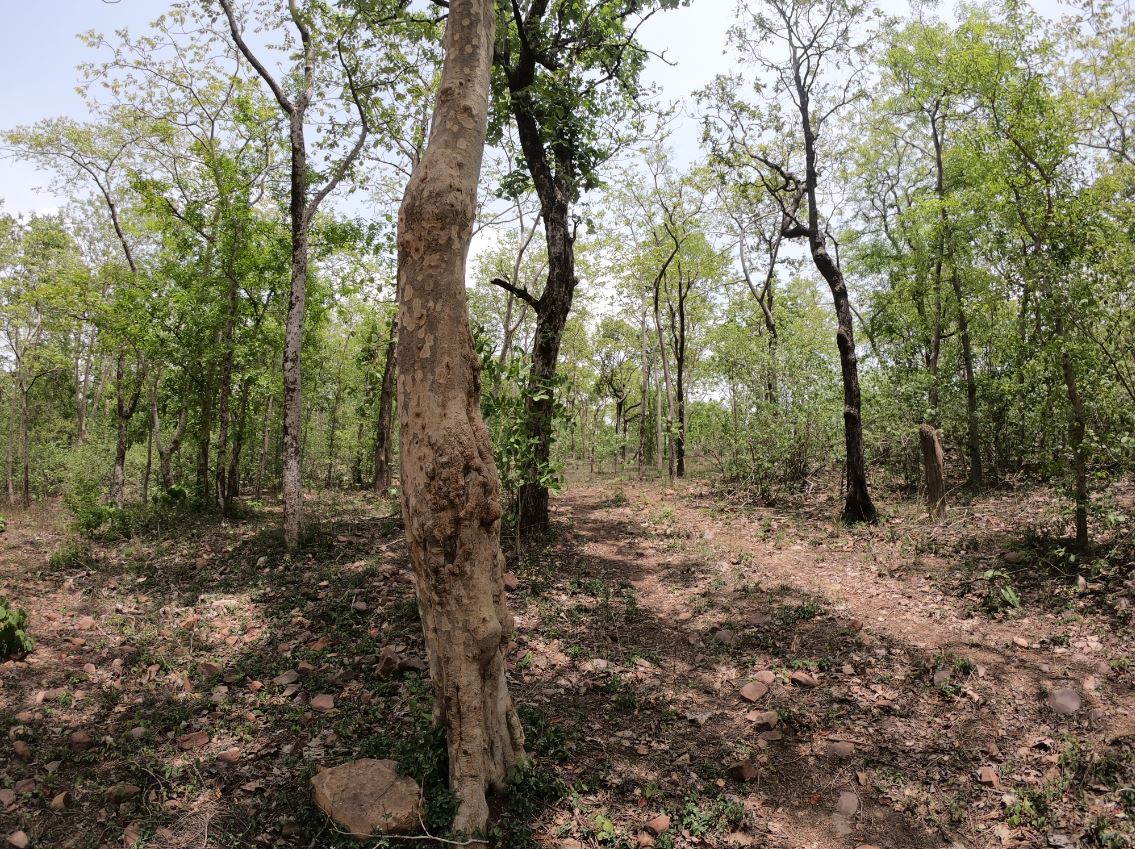
These trees will be felled to make way for Ken-Betwa Link Project. Photo: Dheeraj Mishra.
In the 39th meeting of the Standing Committee of the National Board for Wildlife (SC NBWL) held on August 23, 2016, the National Tiger Conservation Authority (NTCA) had expressed deep concern over the destruction of the tiger habitat spread over 105 sq km because of the submergence and fragmentation that would be caused by the KBLP mainly in the western part of the PTR.
Therefore, the NTCA had proposed integrating the Nauradehi and Rani Durgavati Wildlife Sanctuaries of MP and the Ranipur Wildlife Sanctuary of UP with the Panna Tiger Reserve.
It was in this meeting that the NBWL had granted wildlife clearance to the Ken-Betwa Link Project, which has been challenged in the Supreme Court.
The NTCA had also made it a condition of approval that the areas of Chhattarpur and South Panna Division should be notified as the PTR’s buffer zone due to historical presence of the tiger in the area.
However, sufficient evidence is not available at present to prove that the tiger habitat can be restored by integrating the sanctuaries after it has been destroyed by the KBLP. This is primarily because the three sanctuaries proposed for integration with the PTR do not have secure corridors or habitat connectivity with the tiger reserve.
Information provided by the government shows that the aerial distance from the boundary of the PTR to Nauradehi Wildlife Sanctuary in MP is 108.2 km, to Rani Durgawati Wildlife Sanctuary in MP is 102.1 km and to Ranipur Sanctuary in UP is 73.8 km.
Further, the proposed connectivity of the PTR to the three wildlife sanctuaries passes through densely populated and cultivated areas and there is no corridor connectivity between the PTR and any of the three sanctuaries.
According to Bhopal Singh, the Wildlife Institute of India is preparing a comprehensive landscape management plan for the conservation of wildlife in the Panna Tiger Reserve as a mitigative measure for the damage that will be caused by the proposed Daudhan reservoir.
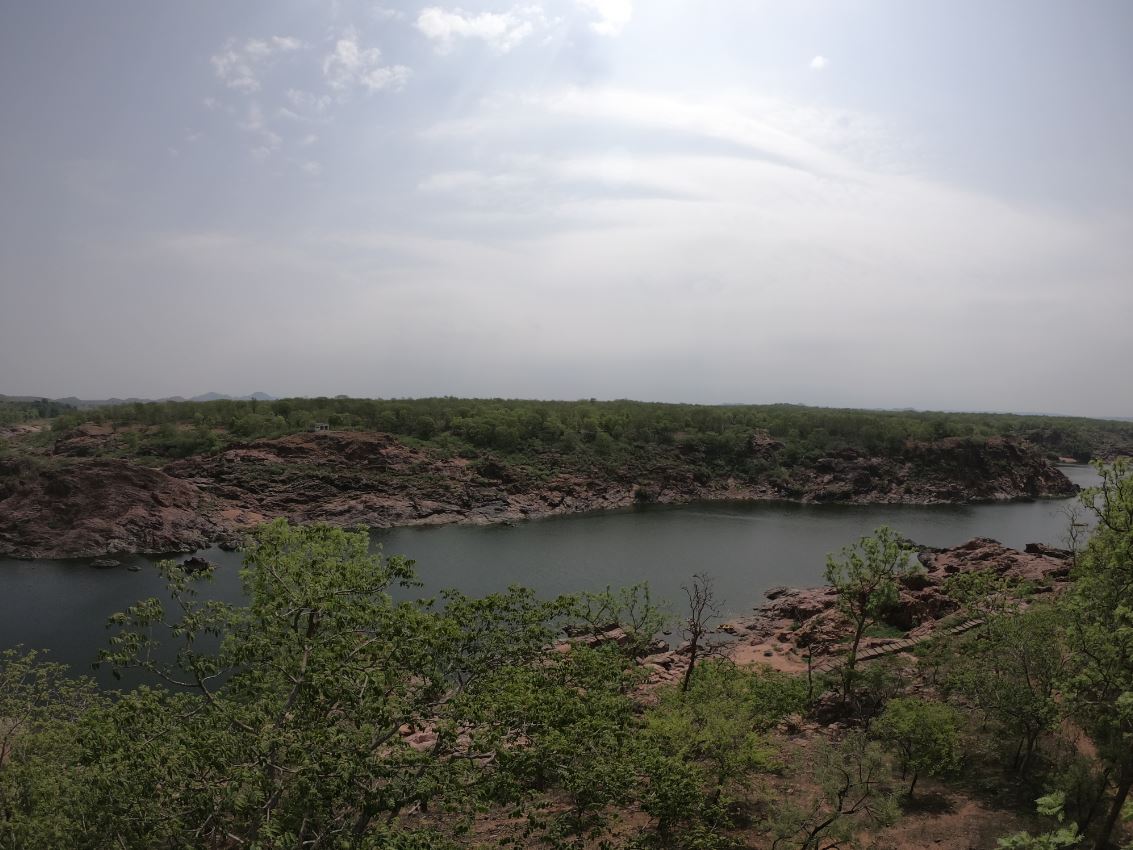
Ken Ghariyal Sanctuary. Photo: Dheeraj Mishra.
He told The Wire: “Not only the PTR area but also the surrounding area of about 47,620 sq. km spread over 11 districts of MP and UP, including forest area of 12,125 sq. km, will be covered under this plan.”
Bhopal Singh also claimed that the project is aimed to not only provide water security in the Bundelkhand region but also ensure the overall conservation of the region, especially for landscape-dependent species such as tigers, vultures and crocodiles.
However, these claims are highly contradictory. It appears that the government’s plan involves wiping out an already existing natural reserve only to attempt to restore it later.
KBLP versus the environment
On World Water Day on March 22, 2021, a tripartite memorandum of agreement was signed for the implementation of the Ken-Betwa River Link Project by Gajendra Singh Shekhawat, the Union Jal Shakti minister, Adityanath, the Uttar Pradesh chief minister, and Shivraj Singh Chouhan, the Madhya Pradesh chief minister, in the presence of Prime Minister Narendra Modi.
The project aims to provide water for drinking and irrigation to the drought-prone Bundelkhand region in UP and MP.
Although experts and the local community insist that this goal can be achieved through other means, the government seems adamant about implementing the project which will cause widespread ecological damage and endanger wildlife.
The project is based on the claim that River Ken has surplus water and therefore this can be linked to Betwa to transfer its water, which itself is a disputed fact. Since the government has never released any hydrological data regarding this claim, it has been challenged at various levels, including in the Supreme Court.
The Ken-Betwa Link Project is to be implemented in two phases. In the first phase, a 77-metre high and 2,031-metre long dam will be constructed at Daudhan village, located near the river Ken.
In addition, a 221-km long Ken-Betwa link canal will be built through which water from the Ken will flow into the Betwa basin. A total area of around 9,000 hectares will be submerged due to the proposed dam, of which 5,803 hectares lies within the Panna Tiger Reserve, which is considered to be the core habitat of tigers in the region.
Section 35 (6) of the Wildlife (Protection) Act 1972 states that the destruction or removal of any wildlife, the destruction, damaging or diversion of the habitat of any wild animal and the diversion, stopping or enhancement of the flow of water into or outside a national park or sanctuary, can only be permitted if it is found to be necessary for the improvement and better management of wildlife.
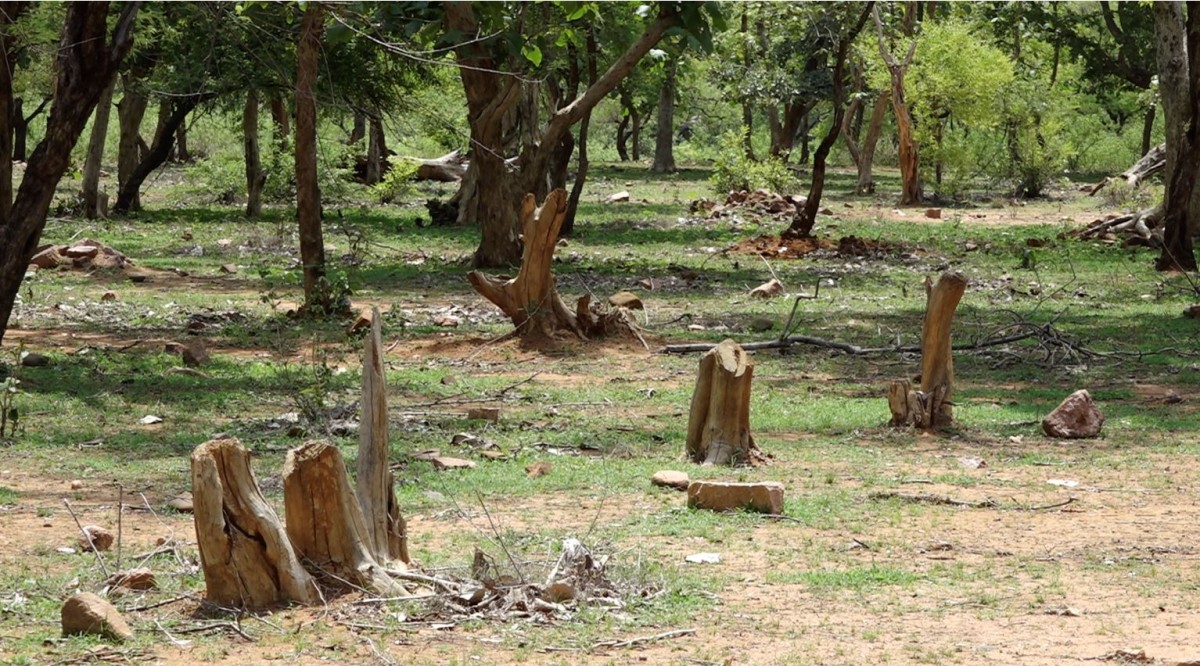
Trees felled outside the reserve area. Photo: Dheeraj Mishra.
The tiger reserve is home to not only tigers but a variety of other animals including vultures, pigs, wild boars, deer, bear, leopards, chinkara, mahaseer fish, hyenas, jackals, foxes, chital, wolves, wild dogs, and red and black faced monkeys.
The construction of the dam will also adversely affect the Ken Gharial Sanctuary.
Moreover, 10 villages will be submerged as a result of the project, which will affect at least 8,340 people.
The sub-committee of the FAC had said in its report that 23 lakh trees of the height of 20 cm or more will be felled under the project.
However, in its report submitted onAugust 30, 2019, the Supreme Court-appointed Central Empowered Committee (CEC) said that while studying the first phase of the Ken-Betwa Link Project, it had observed that the trees of between 10 and 20 cm height had not been enumerated and there was a profuse crop of plants below 20 cm in height.
The CEC report added that the project would take about eight years to complete, during which period these plants would attain a height of more than 20 cm and would eventually be axed. But these trees have not been counted in the data on tree-felling, which is a matter of concern.
Simply put, the CEC believes that the number of trees that will actually be felled during the project is much greater than the number estimated by the FAC.
Tree species found in the region include teak, khair, moringa, salai, gunja, palash, axlewood, tendu, kullu, kardhai, bel, mahua and bamboo, among others.
The project’s second phase involves the construction of the Lower Orr dam, the Kotha barrage and the Bina complex multipurpose project. Based on an assessment in 2017-18, it will cost Rs 35,111.24 crores.
According to the MoA, Madhya Pradesh will get 2,350 million cubic metresof water (MCM) and Uttar Pradesh will get 1,700 MCM of water from the Daudhandam in a normal year.
The government claims that a total of 9.04 lakh hectares of land will be irrigated owing to the project, including 6.53 lakh hectares of land in Madhya Pradesh and 2.51 lakh hectares in Uttar Pradesh.
The districts of Bundelkhand expected to benefit from the project include Panna, Tikamgarh, Chhatarpur, Sagar, Damoh, Datia, Banda, Mahoba, Jhansi and Lalitpur.

The Daudhan dam is proposed to be built two kilometers away from the Gangau dam, which was built on the Ken river by the Britishers. Photo: Dheeraj Mishra.
Interestingly, the existing Bariyarpur dam on the Ken river already has an irrigation target of 2.14 lakh hectares of land in UP. So the net increase in the area of irrigation with the implementation of the KBLP will be only 0.37 lakh hectares in the state of UP.
Similarly, Madhya Pradesh is yet to fully utilise its share of water from the river Ken through the Bariyarpur pick-up weir, although the state has a share of 398.22 MCM of water with a projected command area of 68,356 hectares in the state.
In addition, the information provided by the NWDA shows that the Ken basin already has 11 major/medium and 171 minor irrigation projects under operation.
In view of this, the CEC recommended that the construction of the Daudhan dam and the resulting ecological damage can be avoided since the goals can be achieved merely by expanding the capacity of the existing projects.
Yet, rejecting all the facts and warnings, the Modi government has signed the tripartite agreement and decided to go ahead with the KBRL project.
This story was supported by Internews’ Earth Journalism Network.
Translated from the Hindi by Naushin Rehman.
This article went live on July nineteenth, two thousand twenty one, at ten minutes past six in the evening.The Wire is now on WhatsApp. Follow our channel for sharp analysis and opinions on the latest developments.




